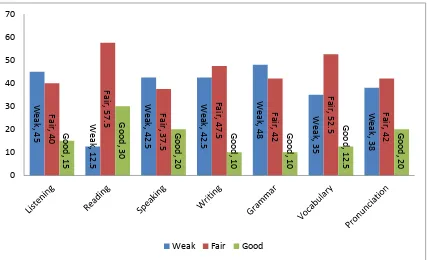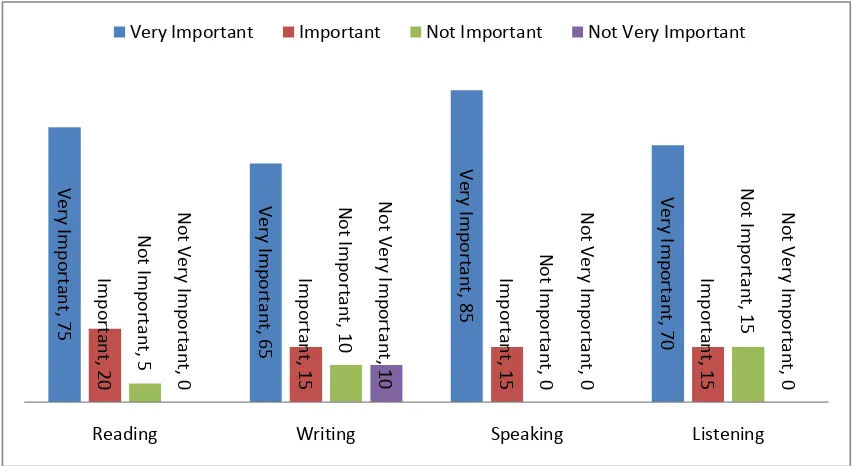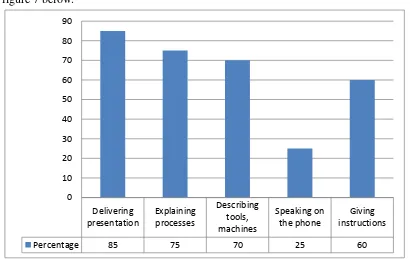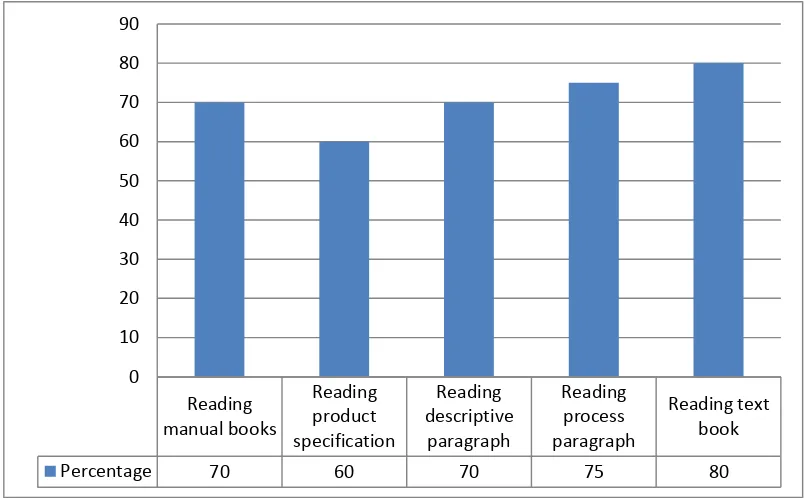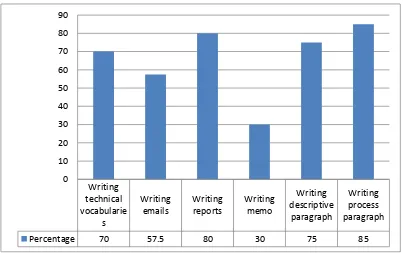Journal of English in Academic and Professional Communication 30 JEAPCo, 4 (2) 2017, ISSN: 2356-2862
ENGINEERING
STUDENTS
’
NEED
OF
COMMUNICATION
SKILLS
Dini Hadiani ([email protected])
Nia Nuryanti Permata([email protected])
Unit Sosio Manufaktur, Politeknik Manufaktur Negeri Bandung, Indonesia
Abstract: This study presents the qualitative analysis of engineering students’
needs of communication skills. Communication skills are recognized as important elements in workplace. However, many engineering students are reported to encounter problems in communicating in English. Therefore, this study tries to identify the engineering students’ needs of communication skills that will help them to seek jobs after graduating. The purpose of this study is to explore the communication skills needs of engineering students as a tool of determining the appropriate teaching material and method. Data were obtained through questionnaires and interviews. The findings revealed the engineering students needs of communication skill and the employers’ view point related to the needs of communication skills in students’ future workplace. It was concluded that communication skills of delivering presentation, explaining tools/machines, writing process paragraph, and reading manuals were important for engineering students and should be brought into the ESP course.
Key words: ESP, needs analysis, communication skills
Introduction
The need of communication skills for engineering students has increased rapidly. Having good communication skills is considered essential in workplace. They are required in every field of work, including engineering field. For this reason, a course in English for Specific Purposes (ESP) is addressed for teaching effective English communication skills for engineers, since ESP which is designed to meet the specific needs of the learners and centered not only on the language (grammar, lexis, and register) but also on the skills and discourses is considered a good way to enhance English language training (Riabtseva and Arestova, 2006; Maria, 2009).
Journal of English in Academic and Professional Communication 31 JEAPCo, 4 (2) 2017, ISSN: 2356-2862
To achieve the effective result of ESP course, there is a need to have suitable information that supports the students’ professional career in the future especially to improve their English communication skills. As an attempt to fill the gap, this study seeks to identify the students’ communication skills needs that can be used to determine ESP instructional materials and methods appropriate to them.
English for Specific Purposes
English for Specific Purposes (ESP) is an approach to language teaching and learning based on the learners’ reasons for learning (Hutchinson and Waters, 1987; Robinson, 1991; Dudley-Evans & St. John, 1998). In line with the idea, Richards and Schmidt in Richards (2001) said that ESP is the role of English in a language course or program of instruction in which the content and aims of the course are fixed by the specific needs of a particular group of learners. Mackay and Mountford in Robinson (1980) also mentioned that the purposes of ESP are occupational requirement, vocational training, and academic or professional study. It can be inferred that ESP is a form of English teaching given to special group of learners for special purposes, on the basis of what and why the learners learn English.
There are a lot benefits can be reached by implementing an ESP approach. It embraces students’ learning speed, learning efficiency, and learning effectiveness (Wright, 1992). ESP embraces the students’ learning speed means that it can bring a quicker acquisition of required language points. Learners, therefore, can learn English in a content-based context. ESP also embraces the students learning efficiency because learners use their learning resources optimally by having previous identification of expected linguistic items and skills (Wright, 1992; Harmer, 2001). The identification is done through needs analysis, so that it can allow teacher to determine the specific requirements of the learners. Finally, ESP embraces the students learning effectiveness since they are expected to be ready to use language appropriately and correctly in specific purpose tasks. The tasks should also be determined by conducting needs analysis, so the learners can develop their language skill effectively.
Based on the explanation stated previously, it is clear that before starting an ESP course, needs analysis should be conducted to find out what is needed by learners in learning English, the context related to it, and the current English level the students have.
Needs Analysis
In general, to prepare an ESP course needs several different stages. One of which is very important is Needs Analysis (NA). Since the main purpose of ESP is to fulfill the needs of the learners, NA is done to identify the specific needs of the students taking the language program.
Needs analysis is the process of determining the needs for which a learner or group of learners requires a language and arranging the needs according to priority (Richards and Schmidt in Richards, 2001). It means that needs analysis plays an important role in developing materials that meet the learners’ needs. Richards (2001) strongly stated that an important concern in ESP is needs analysis.
Journal of English in Academic and Professional Communication 32 JEAPCo, 4 (2) 2017, ISSN: 2356-2862
lacks. In their classification, necessities are concerned with the demands of target situations, lacks refer to the gap between learner’s existing language proficiency and the needed target situation language needs, and wants relate to learners’ view on what their needs are.
In line with the idea, Robinson (1991) categorizes needs analysis into Target Situation Analysis (TSA) and Present Situation Analysis (PSA). The former refers to the learners’ needs and expectation after they finish the language course. The latter concerns about things that the learners should know before taking a language learning and knowing their strengths and weaknesses. It can be concluded that before starting any ESP courses, NA should be done to investigate the students’ needs related to their necessities, wants, and lacks and it also involves TSA and PSA.
Communication Skills
Communication skills refer to the ability to convey a message along with the feeling behind it, for purpose of the desired effect. Thus, it includes various aspects of conveying - verbal, nonverbal and interpersonal (Atre, et.al, 2013).
The importance of communication skills for engineering students and engineers has been widely reported, with emphasis on non-native speakers of English. Batley (1998) claims that many engineers may have strong quantitative skills while remaining comparatively weak in verbal skills. This can be problems since employers are demanding graduates who have excellent not only written but also oral and listening skills.
As it was stated previously, communication skills of listening, speaking, reading, and writing are essential for engineers to work well in their jobs. Reimer (2007) states that communication skills are essential for an engineer who aspires to carry out his/her professional practice in the global areas. Furthermore, Patil (2014) claims that getting the work done in effective manner has become more important than having the most knowledge. Effective communication reinforces positive impression of the engineer. It means that having a good communication skill is very important for engineering students to seek for their future jobs.
Journal of English in Academic and Professional Communication 33 JEAPCo, 4 (2) 2017, ISSN: 2356-2862
information processing, storage and retrieval. This can be the ability to understand manual books of a machine or tool. It is clear that every engineering profession relies heavily on the use of visual forms as a means of non-verbal communication.
Methodology
This study employed a descriptive qualitative method. It was carried out at the undergraduate mechanical engineering study program at one polytechnic in Bandung. The participants of the study were forty students of Technical English subject, and two employers from engineering field.
The data were collected through the questionnaires and interview. The questionnaire was designed to find out the engineering students’ needs of communication skills. There were several various types of questions including the close-ended, open-ended, and ranking questions. The questions were used to identify the students’ target
situations, the gap between learner’s existing language proficiency and the needed target
situation language needs, and the students’ needs of communication skills in English. The other source of data was the interview with some students and employers. There were twelve students who were willing to be interviewed. The employers were from multinational companies. The interview was done to obtain more comprehensive data on the students’ needs of communication skills and the view points from the employer about the needs of communication skills in real workplace. These can be used for determining the appropriate instructional material and method to teach Technical English Subject in the research site.
As for data analysis, the students’ questionnaries are tabulated and made into percentage. Then, the results are analyzed and triangulated with data obtained from interview.
Findings and Discussions
The findings of the research provided valuable insights on the engineering students’ needs of communication skills. The findings are presented in two parts. Part one presents the results from questionnaires, and Part 2 elaborates the data obtained from the interviews.
Findings from Questionnaires
Journal of English in Academic and Professional Communication 34 JEAPCo, 4 (2) 2017, ISSN: 2356-2862
Weak
Figure 1. The Students rating on their current language skills
As it can be seen in figure 1, almost half of the students (48%) have rated grammar skill as their weakest skill. They admitted that they still have problems in mastering the grammar of English. This reveals that there is a need to improve the
students’ grammar skill to support their communication skills. It is therefore
recommended for the students to be given explicit teaching on grammar points that will be useful for them. This idea is supported by Riabtseva and Arestova’s (2006) statement on the importance of the teaching of basic language concepts. Apart from that, the result shows that the students rated their current language skills as in ‘fair category’. Whereas
the students’ mastery of vocabulary and pronunciation 52.5% and 42% respectively that
can be categorized into “fair category’ as well. This shows that the students needed more
time allotted to develop not only their communication skills, but also the English language elements. The process of learning ESP should focus on those categories of language skills and English language elements of grammar, vocabulary and pronunciation.
Concerning the students’ opinion about the importance of English for their future professional career can be seen in the following figure. The students were asked to rank the language skills from very important to the least important in workplace.
Journal of English in Academic and Professional Communication 35 JEAPCo, 4 (2) 2017, ISSN: 2356-2862
tended to work in multinational companies that require their employees to use English in their daily work. Having good oral communication skills will make them easy to get jobs.
V
Very Important Important Not Important Not Very Important
Figure 2. The Language Skills needed by engineers in their job
In relation to the students’ responses to their language learning objectives, it was found that the students wanted to improve their speaking skill. There are 85 percent of the participants that represents 34 students said that they study English because they wanted to become more fluent speaker. The other 80 percent that represents 32 students preferred to improve their presentation skill. This confirms that the students would like to improve their productive skill during oral communication. The detail result can be seen in figure 3.
The data show that speaking skill is still considered the most used skill in their future job that needs paying more attention. Being a good communicator will make them easy to convey ideas related to engineering background. This is supported by Cullen and Pudwill’s (2002) statement that engineers need to be able to communicate their technical expertise effectively.
In terms of the topics of ESP that can be learned in ESP course, the students put forward various answers. The students’ responses can be seen in figure 4. It describes the
students’ responses on the topics for ESP classes. The topic about describing processes
Journal of English in Academic and Professional Communication 36 JEAPCo, 4 (2) 2017, ISSN: 2356-2862
80 85 80
70
65
75
62.5 75 Percentage
Figure 3. The skills during oral communication
75
82.5
62.5
80
90
57.5
75
Engineering materials
and properties
Shapes and dimensions
Number and quantities
Describing technical
object
Describing processes
Safety at work, hazard, instruction
Places of work (Workshop, laboratories) Percentage
Figure 4. Students’ Responses on Topics for ESP
Journal of English in Academic and Professional Communication 37 JEAPCo, 4 (2) 2017, ISSN: 2356-2862
30
80
60
37.5
62.5
Individual Group work Whole Class Out of Class work Pair Work
Percentage
Figure 5. The Students Preferences of Activities in Learning English
From Figure 5, it can be seen that students most likely to have group work (80%) in learning ESP, pair work (62.5%) and whole class activities (60%). Students do not seem to prefer individual activities in learning ESP (30%). It confirms that the students preferred to have group work, so they can cooperate with their friends and share problems if there is any. This is in line with the facts that group work encourages broader skills of cooperation and negotiation that help the students’ social aspect and develop their generic skill (Harmer, 2001).
Concerning the communication skills needs that are required by engineers, especially in different language skills can be seen in the following figures. Figure 6 shows the students’ needs of communication skills in terms of listening skill. The students needed the listening skills mostly during the presentations (80%), followed by during lectures (70%), instructions (67.5%), explanations of their teacher (65%), and reports (50%). The students stated that listening skill is important especially to understand information during group presentation, during lectures, and to comprehend subject explained by the teacher. Some students admitted that sometimes they experienced problems in mastering this skill due to their lack of English skill. This is in line with Rubin-Pernia (2013) that for students not being able to master the listening skill would mean difficulty passing their subjects.
Journal of English in Academic and Professional Communication 38 JEAPCo, 4 (2) 2017, ISSN: 2356-2862
Listening to
Figure 6. The Students Needs of Communication Skills in terms of Listening
In terms of speaking skills, students’ needs of communication skills is elaborated
Figure 7. The Students Needs of Communication Skills in terms of Speaking
Journal of English in Academic and Professional Communication 39 JEAPCo, 4 (2) 2017, ISSN: 2356-2862
related to their expertise, i.e. engineering. This is line with Cullen and Pudwill’s (2002) finding that the ability to give a presentation is a particularly important skill for engineering students to acquire, since engineers are often asked to give technical explanation on product design or manufacturing processes. This is also supported by Riemer (2007) who states that oral communication and presentation skills are two essential skills that should be mastered by engineering students. Knowledge and technical know-how are clearly important, but these must be presented with an excellent standard of communication skills, particularly oral.
On the other hand, related to the students’ needs of communication skills in terms of reading skills, the result can be seen in Figure 8 below.
Reading manual books
Reading product specification
Reading descriptive
paragraph
Reading process paragraph
Reading text book
Percentage 70 60 70 75 80
0 10 20 30 40 50 60 70 80 90
Figure 8. The Students Needs of Communication Skills in terms of Reading
The reading skill is admitted to be used in understanding the text book (80%), the process paragraph (75%), descriptive paragraph (70%), manuals (70%) and the product specifications 60%). The machines or tools are usually presented with manual books with pictures, symbols, and graphs. The ability to understand visual language which is included in non-verbal communication will build the students to become qualified engineers (Riemer, 2007). The students commented that reading skill is important to know detail information about machine or tools related the engineering field. If not, they thought they will face problems especially if they mistakes in understanding the detail specification of machines or tools.
Journal of English in Academic and Professional Communication 40 JEAPCo, 4 (2) 2017, ISSN: 2356-2862
Writing
Percentage 70 57.5 80 30 75 85
0
Figure 9. The Students Needs of Communication Skills in terms of Writing
The students admitted that writing is the least frequently used and the most difficult skill. It needs much effort to master writing skill, since it requires the correct grammar mastery and perseverance (Riemer, 2007). Hence, the students needed to improve this skill because if they work in a multinational company they had to communicate in written form including writing reports, writing descriptive and process paragraphs with specific technical vocabularies, writing email, and writing memo.
Based on the findings from questionnaires, the engineering students needed all four English language skills of listening, speaking, reading, and writing in their future workplace. The ESP course in the research site should cover the topics needed related to the students’ field, which is engineering field. To be able to have good communication skills, the students needed more allotted time to improve their language skills, and also the English language components of grammar, vocabulary, and pronunciation.
Finding from Interview
The interview was done to two employers from multinational companies that run machine spare parts and automotive business. The multinational company requires the employees to use English in their daily work, such as in writing a weekly report, during meeting, meeting clients, presenting new projects, etc.
Based on the result of interview, all employers agreed that English communication skills were very important in workplace. The employers said that the engineers needed these language skills to carry out the communication effectively. They added that engineers needed English especially for daily communication and technical English to do their work effectively.
Journal of English in Academic and Professional Communication 41 JEAPCo, 4 (2) 2017, ISSN: 2356-2862
engineers had to work with foreign bosses, managers, supervisors and experts. During their work, they had to be able to express their ideas or present their solutions to technical issues effectively; they also had to report their work progress or technical problems to their foreign supervisors and managers. For these reasons, becoming a good speaker will make them easy to communicate effectively and successfully.
In relation to using reading skill in daily work, all employers said that this skill was important. It is not only used to understand the manual books of machines or tools, but also to know the products’ specifications in details. The lack of reading skill will lead to serious problems, for example they would make mistakes in ordering spare parts and installing devices.
The students needed receptive communication skill i.e. listening skill which is used in daily work especially to do their daily tasks. The engineers had to listen to the boss or manager’s instructions. They also had to understand presentations and discussions in meetings, seminars or conferences. Having a good listening skill will be beneficial to do their daily tasks easily.
Concerning the function of writing skill in workplace, the employers claimed that this skill was quite difficult because it requires grammar mastery. This skill was needed mostly for email communication and writing technical reports.
The employers further suggested that undergraduate engineering students should improve their English communication skills as these skills are very important in workplace. They also stated that there is a need to include the communication skills into the curriculum. The teaching of communication skills therefore can be given both in the English instruction classroom and content specific subjects.
Conclusions
The findings of the study have revealed the real engineering students’ need of communication skills. It is found that the results correspond to the identified needs of the target group of learners. The results also show that the participants have different skills and expectations related to their needs to use the target language in their future career. Furthermore, the identification of the students’ needs of communication skills which was carried out through needs analysis provides fruitful information to the preparation of ESP course.
In conclusion, several important aspects can be drawn from the needs analysis questionnaire, and interviews that help to identify the engineering students’ needs of communication skills. The communication skills of delivering presentation, explaining tools/machines, writing process paragraph, and reading manuals were important for engineering students and needed to be emphasized in the ESP course. Based on the findings needs analysis is very important to be performed before commencing an ESP course, so that it can meet the students’ specific needs.
References
Journal of English in Academic and Professional Communication 42 JEAPCo, 4 (2) 2017, ISSN: 2356-2862
Batley, T. (1998) “Management Training of Professional Engineers in New Zealand”. Journal of European industrial training, 22(7), pp 309-312, retrieved on April 15 2014 from http://dx.doi.org/10.1108/03090599810230713
Cullen, B. & Pudwill, L. (2002). ‘Presentations in The Technical English Classroom’. Bulletin of Nagoya Institute of Technology, 53 pp 57-64. Dudley-Evans, T., & Maggie, J. S. J. (1998). Developments in English for Specific
Purposes:A Multi-Disciplinary Approach. Cambridge: CUP.
Harmer, J. (2001). The Practice of English Language Teaching. England: Pearson Education Limited.
Hutchinson, T and Waters, A. (1987). English for Specific Purposes: A Learning Centered Approach. Cambridge University Press.
Maria, P. O. (2009). ‘Techniques of Teaching English for Engineer’, [Online]. Accessed on 12 February 2014 from http://www.wseas.us/e- library/conferences/2009/budapest/DIWEB/DIWEB06.pdf
Patil, M.R., (2014). ‘Importance Of English Communication For Engineering Students From Rural Areas And Its Remedies’. IOSR Journal of Mechanical and Civil Engineering (IOSR-JMCE) ISSN: 2278-1684, PP: 35-38 www.iosrjournals.org Riabtseva, E.V. and Arestova, A.A.(2006). “Some Problems of Teaching English for
Special Purposes to Students of Technical Specialities at University Level.”
Transactions TSTU, Retrieved on 1 September 2016 from
https://www.scribd.com/document/203399157/Some-Problems-of-Teaching-English-for-Special-Ryabceva
Reimer, M.J. (2007). ‘Communication Skills for the 21st Century Engineer’, Global Journal of Engineering Education. [Online]. Accessed on 20th September 2016 at https://pdfs.semanticscholar.org/6976/2a3c558cbe2a20d59fb362718ac269da8bca. pdf
Richards, J. C. (2001). Curriculum Development in Language Teaching. Cambridge, U.K. ; New York: Cambridge University Press.
Robinson, P.C. (1980). English for Specific Purposes: The Present Position. Pergamon Press.
Robinson, P.C. (1991). ESP Today: A Practitioner’s Guide. New York: Prentice Hall. Rubin-Pernia, W. (2013). ‘Communication Skills Needs of Technical English I Students:
Basis for the Development of Instructional Materials’. UIC Research Journal. 2013.19(1) at http://research.uic.edu.phlojs/
Stevens, B. (2005). ‘What Communication Skills Do Employers Want? Silicon Valley Recruiters Respond’. Journal of Employment Counseling, 2005. 42(1): 2. Retrived
on 2 September 2016, from
http://proquest.umi.com/pqdweb?did=814722011&sid=1&Fmt=4&clientId=21690 &RQT =309&VName=PQD
